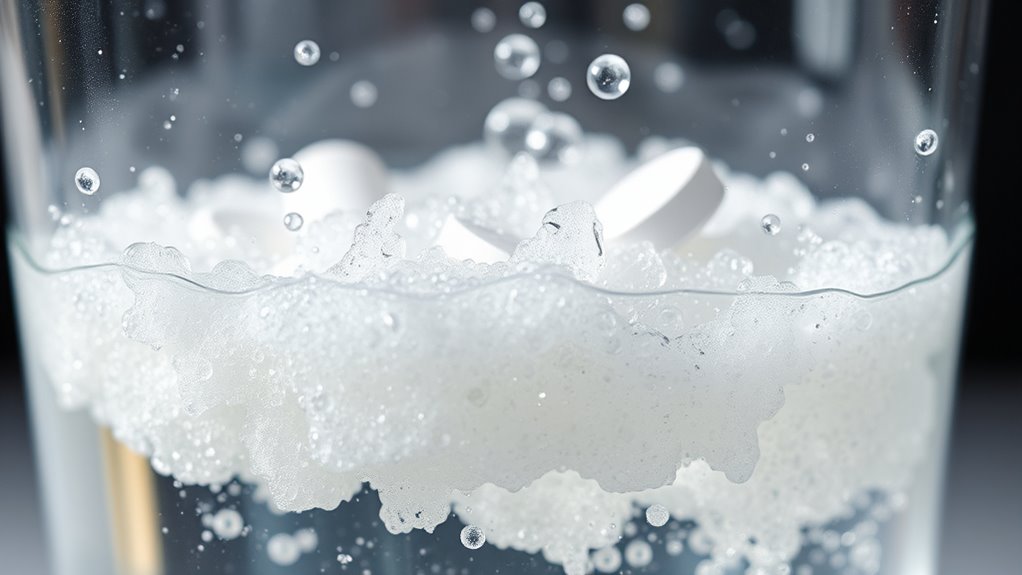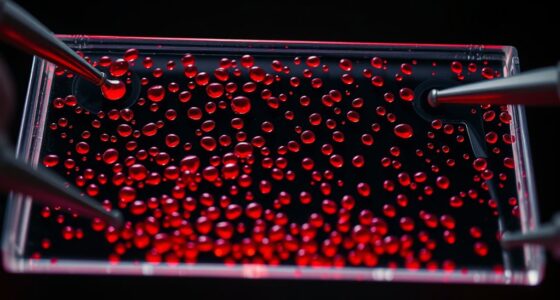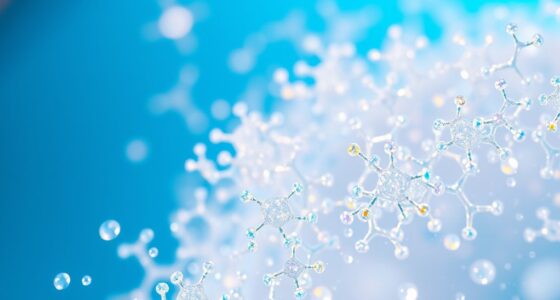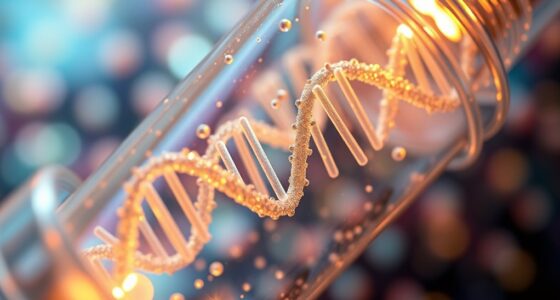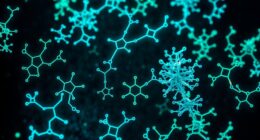When your antacid fizzes, it’s because of a chemical reaction between ingredients like magnesium hydroxide or calcium carbonate and hydrochloric acid in your stomach. This reaction produces carbon dioxide gas, which creates bubbles and the fizzing sensation. This process helps neutralize excess acid quickly, providing relief from heartburn. The fizz is a sign that the neutralization is happening effectively. Keep going to uncover more about how this clever reaction works to ease your discomfort.
Key Takeaways
- Antacids contain bases like magnesium hydroxide or calcium carbonate that react with stomach acid (HCl).
- The fizzing results from the production of carbon dioxide (CO₂) gas during acid-base neutralization.
- CO₂ bubbles create bubbling, indicating active chemical reactions that help neutralize excess stomach acid.
- The fizzing process enhances the distribution of the antacid, speeding up relief from heartburn.
- This gas release visually confirms the neutralization process, signaling effective relief through molecular chemistry.

Ever wonder why some antacids fizz when you take them? That bubbling action isn’t just a fun reaction—it’s the result of a clever chemical process that provides relief from heartburn. When you swallow an antacid tablet or liquid, it enters your stomach, which is often too acidic if you’re experiencing indigestion. To counter this, the main goal is pH neutralization, a process where the acidity is balanced out to ease discomfort.
The active ingredients in antacids, such as magnesium hydroxide or calcium carbonate, react with the excess stomach acid—primarily hydrochloric acid (HCl)—to form water and other neutral compounds. This reaction effectively raises the pH level, bringing it closer to neutral, which alleviates the burning sensation.
Now, here’s where the fizzing comes into play. When these antacid compounds come into contact with stomach acid, they undergo a chemical reaction that produces carbon dioxide gas. This carbon dioxide formation is what causes the characteristic bubbling or fizzing. Basically, the antacid acts as a base, and the hydrochloric acid acts as an acid, so they react in a classic acid-base neutralization.
When antacids react with stomach acid, they produce carbon dioxide gas, causing fizzing and helping neutralize harsh acidity.
As the base dissolves, it generates CO₂ gas—think of it like a mini volcanic eruption inside your stomach, but much less dramatic and more helpful. The release of this gas creates the bubbles you see and feel as fizzing. This bubbling effect isn’t just a side effect; it helps distribute the antacid throughout your stomach, ensuring a faster and more even neutralization of excess acid.
The fizzing also signals that the chemical reaction is happening in real-time, which means your stomach acid is actively being neutralized. The formation of CO₂ gas is a natural byproduct of the chemical process designed to give you quick relief. It’s a sign that the antacid is doing its job, converting the harsh, acidic environment into a more neutral one.
Furthermore, understanding the chemical reactions involved can help you choose the most effective antacid for your needs. This reaction doesn’t just make the antacid fizz; it actively reduces the irritation and damage caused by stomach acid on your esophagus. So, next time your antacid fizzes, remember it’s a small but powerful demonstration of chemistry working to bring you comfort—pH neutralization happening right in your stomach, with carbon dioxide formation as a helpful byproduct.
Frequently Asked Questions
Can Antacid Fizzing Cause Any Side Effects?
You might wonder if antacid fizzing causes side effects. Generally, fizzing itself isn’t harmful, but ingredient interactions can lead to issues like constipation or diarrhea.
If you’re allergic to ingredients like sodium bicarbonate or calcium carbonate, you could experience allergic reactions such as hives or swelling.
Always check labels and consult your doctor if you notice unusual symptoms, especially if you have allergies or are taking other medications.
Do All Antacids Fizz the Same Way?
Not all antacids fizz the same way because they rely on different chemical reactions and effervescence mechanisms. Some contain ingredients like sodium bicarbonate that produce rapid fizzing when they react with stomach acid.
Other antacids use different compounds that fizz more slowly or not at all. Your experience depends on the specific formulation and how the chemical reactions are designed to neutralize acid efficiently and safely.
How Quickly Does the Fizzing Neutralize Stomach Acid?
Did you know that antacids typically start fizzing within seconds of contact? This rapid chemical reaction causes a quick pH change, neutralizing stomach acid effectively.
You’ll notice the fizzing almost immediately, usually within 30 seconds, as the antacid reacts with the acid. This swift action helps relieve heartburn fast, making it a convenient solution when discomfort hits.
The speed of this process depends on the antacid’s formulation and the amount of acid present.
Is the Fizzing Process Safe for Children?
You might wonder if the fizzing process is safe for children. Generally, antacids are formulated with children safety in mind, but you should always check labels and consult your doctor.
The fizzing safety depends on the ingredients and dosage; some formulations are specifically designed for kids. Never give adult antacids to children without medical advice, as improper use could cause adverse effects.
Always prioritize safety for your child’s health.
Can Excess Fizzing Indicate an Overdose of Antacid?
Imagine a vintage soda fountain bubbling over—that’s what excess fizzing in your antacid can resemble. If you notice intense or persistent fizzing, it could be a sign of overdose symptoms, meaning you’ve taken too much.
Fizzing indicators like this suggest your stomach’s pH balance is off. To stay safe, stick to recommended doses, and if symptoms worsen, consult a healthcare professional immediately.
Conclusion
Now that you know why your antacid fizzes, you can see it’s more than just a simple reaction—it’s a clever way to deliver relief quickly. Understanding the science behind it helps you appreciate how these tiny bubbles work to neutralize stomach acid and soothe heartburn. So, next time you reach for that fizzing tablet, remember it’s not just a quick fix but a small miracle happening right in your stomach. It’s good to know the science behind the fizz!
